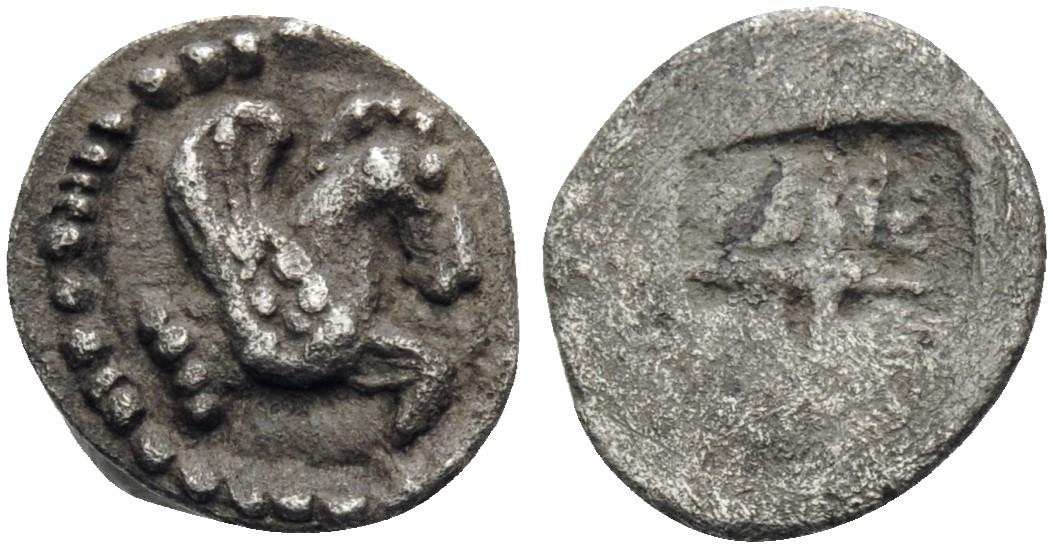Argilos, silver, 48th staters (470-455 BCE)
From SILVER
470 BCE - 455 BCE Silver 191 kg
Description
| ObverseInscription or printing placed on the obverse.: | Protome of Pegasus left or right. Border of dots. |
| ReverseInscription or printing placed on the reverse.: | Quadripartite incuse square. |
Mint and issuing power
| MintIdentifies the place of manufacture or issue of a numismatic object.: | Argilos | Ancient regionAncient region.: | Macedon | Modern countryModern country: Greece | AuthorityIdentifies the issuing power. The authority can be "pretended" when the name or the portrait of X is on the coin but he/she was not the issuing power. It can also be "uncertain" when there is no mention of X on the coin but he/she was the issuing power according to the historical sources: |
Chronology
| FromIdentifies the initial date in a range assigned in a numismatic context. | 470 BCE | toIdentifies the final date in a range assigned in a numismatic context.. | 455 BCE | PeriodTime period of the numismatic object.: Classical 480-323 BC |
Physical description
| MetalThe physical material (usually metal) from which an object is made.: | Silver |
Median weightMedian of the weights of numismatic objects (in grams). in grams | 0.30 | DenominationTerm indicating the value of a numismatic object. Examples: tetradrachm, chalkous, denarius.: | 48th stater | StandardStandard.: |
Image

S89 Argilos 48th.jpg [1]
References
| Die study referencePublication of the study: | Liampi 20051Liampi 2005, p. 179-188, n° 101-127 | ||
| Coin series referenceReference to coin series study: | HGC 3.12HGC 3.1, n° 481 | ||
Obverse dies distribution
| FrequencyFrequency of specimen in distribution. ᵖ | Number of obversesNumber of obverse dies. ᵖ (o) | % (o) | Number of coinsNumber of coins. (n) | % (n) | Die nameName(s) of the die(s). |
| 1 | 14 | 53.85 | 14 | 16.09 | 83, 86, 89, 91, 92, 94, 95, 97, 98, 100, 102, 103, 107, 108 |
| 2 | 3 | 11.54 | 6 | 6.9 | 88, 90, 101 |
| 3 | 2 | 7.69 | 6 | 6.9 | 93, 106 |
| 4 | 2 | 7.69 | 8 | 9.2 | 87, 96 |
| 5 | 2 | 7.69 | 10 | 11.49 | 85, 105 |
| 8 | 1 | 3.85 | 8 | 9.2 | 104 |
| 11 | 1 | 3.85 | 11 | 12.64 | 84 |
| 24 | 1 | 3.85 | 24 | 27.59 | 99 |
| Total | 26 of 26 | 100.01 | 87 of 87 | 100.01 |
Reverse dies distribution
no distribution is available
Quantification
| Number of obversesNumber of obverse dies. ᵖ (o) | 26 | Number of singletons (o1)The number of singleton coins. ᵖ | 14 |
| Number of reverse diesNumber of reverse dies. (r) | 22 | Number of coinsNumber of coins. (n) | 87 |
| Coins per obverse dieNumber of coins per obverse die. (n/o) | 3.35 | Coins per reverse dieNumber of coins per reverse die. (n/r) | 3.95 |
| Reverse per obverse ratioRatio of obverse dies divided by reverse dies. (r/o) | 0.85 | Percentage of singletons (o1)number of coins (n) divided by the number of singletons (o1) ᵖ | 53.85 % |
| Original number of dies (O) (Carter 1983 formula)The estimation of the number of coins according to Carter 1983 ᵖ | 31.82 | Coins struck if 20,000 as average productivity per dieCoins made if the average productivity for obverses (according to Carter) is 20,000. ᵖ | 636,400 |
| Original number of dies (O) (Esty 2011 formula)The estimation of the number of coins according to the singleton formula in Esty 2011 ᵖ (O) | 37.08 | Survival rate if 20,000 as average productivity per dieSurvival rate if average productivity is 20,000. ᵖ | 0.00014 |
| Coverage (o = % of O) (Esty 1984 formula)Esty 1984 - coverage (% of O) ᵖ (o = % of O) | 83.91% | Die productivity if survival rate 1/2,000Average productivity if survival rate is 1/2,000. ᵖ | 5,468.26 |
| Weight of silver (in kg) if 20,000 coins per die (O = Carter formula)Carter 1983 * Median weight * 20000 (*10 if gold or electrum) ᵖ | 191 kg <br /> 191 kg | Die productivity if survival rate 1/5,000Average productivity if survival rate is 1/5,000. ᵖ | 13,670.65 |
Remarks
Most likely one single workstation Metrology p. 230-249; Liampi 2005, p. 191-192, n° 128-130: reverse: APKI in quadripartite incuse square